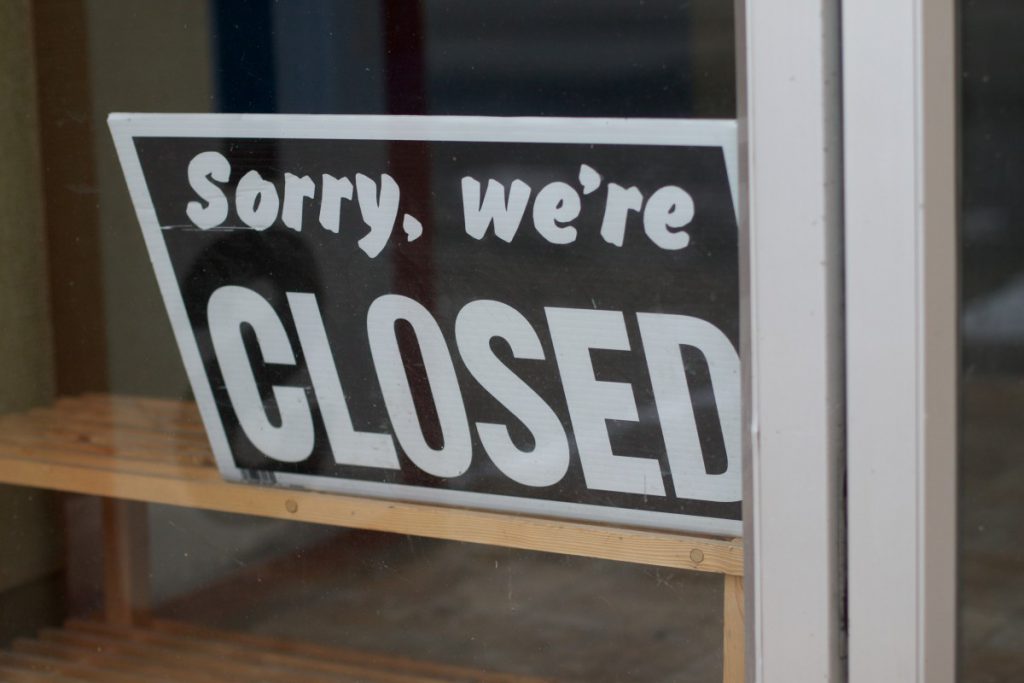State Residents’ Income Seesaws
Average income rose 36% in second quarter, dropped 15% in third quarter of 2020.

Closed. Photo by Alan Levine. (CC BY 2.0).
Wisconsinites’ saw their income drop over the summer, marking the first time income has decreased statewide since the start of 2020, according to data from the U.S. Bureau of Economic Analysis (BEA).
Wisconsinites’ personal income — including paychecks, rental income, and government assistance, among other sources — fell by an annual rate of 14.5 percent in the third quarter of 2020 to a combined $326 billion, down from about $339 billion in the second quarter.
The drop follows a dramatic 35.9 percent annual rate increase in Wisconsinites’ income in the second quarter, driven by billions of dollars in aid from the federal government that was issued to Americans between April and June.
The steep drop-off seen in Wisconsin between July and September reflected the expiration of key parts of that federal aid, including a program that boosted unemployment benefits by $600 a week and stimulus checks of $1,200 or higher sent to many Americans. At that point, many businesses had also finished tapping money given to them under the federal Paycheck Protection Program (PPP), which awarded forgivable loans to help cover payroll costs and other expenses.
What followed was a months-long stretch many struggling businesses and out-of-work Wisconsinites endured with no additional help from Congress, leading many to pull back on spending for even basic necessities and bills.
But as Wisconsin families saw their income dropping, the state’s economy appeared to be booming by different metrics. Over the same time period between July and September, Wisconsin’s GDP rose 40 percent, according to BEA data, a dramatic spike.
University of Wisconsin-Milwaukee economist Kundan Kishor called these contradictory signals from the state’s economy a “historical divergence” of two data points — personal income and gross domestic product (GDP) — that are often in greater alignment.
Kishor said the explanation lies in the timing of that economic relief from Congress. Much of it made its way into Wisconsinites’ bank accounts in the second quarter between April and June. But with Wisconsin’s now-defunct stay-at-home order in effect for part of that time and general fear about being in public amid the pandemic, many Wisconsinites were not able to fully spend that aid until later in the summer.
That means, Kishor said, the drastic rise in the state’s GDP between July and September is the result of those billions of dollars in federal economic relief finally making their way through the economy. But conversely, because much of those same federal aid programs also expired between July and September, Wisconsinites saw their income go down in the same period.
In the latest round of federal coronavirus relief that was signed into law in late December, Congress restarted many of the major economic relief programs but in a pared down fashion, with a weekly unemployment supplement of $300 and a stimulus check that started at $600 for many Americans.
But even with new economic aid being sent out, many families relying on unemployment assistance and businesses counting on PPP funds have said that delays in the aid from Congress along with problems with how the aid is deployed have left them feeling like they can’t count on government aid.
UW-Madison regional economist Steve Deller agreed, saying families and businesses pull back when there’s any kind of uncertainty.
“We dropped the ball on two fronts: one is we got sloppy with public health practices,” Deller said, noting that a lack of attention to public health measures likely spurred a second wave of the virus. “And we got sloppy with … continued stimulus coming out of Washington.”
It remains unclear when income data will reflect the full effect of the latest federal efforts to boost the economy. Stimulus payments have already started making their way into bank accounts, but the timeline for the $300 unemployment supplement is fuzzy, with state officials saying they hope to start sending payments out by mid-January. Officials also haven’t been able to share any timeline for setting up two other crucial unemployment programs, leaving many Wisconsinites without unemployment aid entirely.
Listen to the WPR report here.
Wisconsinites’ Income Dropped 14.5 Percent Between July And September was originally published by Wisconsin Public Radio.

















